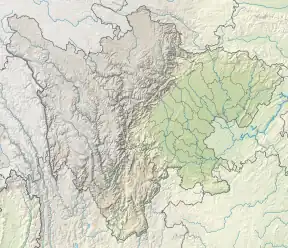Chengdu Huangcheng Mosque
The Chengdu Huangcheng Mosque (Chinese: 成都皇城清真寺; pinyin: Chéngdū Huángchéng Qīngzhēnsì; lit. 'Mosque in the Imperial City Wall of Chengdu') is a mosque in Qingyang District, Chengdu, Sichuan Province, China. It is the largest mosque in Sichuan.
| Chengdu Huangcheng Mosque | |
|---|---|
成都皇城清真寺 | |
 | |
| Religion | |
| Affiliation | Islam |
| Branch/tradition | Sunni |
| Location | |
| Location | 2 Xiaohe Street, Qingyang, Chengdu, Sichuan, China |
 Sichuan | |
| Geographic coordinates | 30°39′33″N 104°3′38″E |
| Architecture | |
| Type | mosque |
| Style | Arabic, Ming, Qing |
| Date established | 16th century |
| Completed | November 1998 |
| Demolished | 1917 |
Name
Huangcheng means Palace Wall because of the mosque location near to a palace of a dynasty in the local history of Sichuan, thus the mosque was name such.[1]
History
The mosque was originally constructed in the 16th century. It was first rebuilt in 1858. In 1917, it was heavily damaged during a war. Subsequently, the size was reduced from 6,600 m2 to 5,000 m2 due to financial constraint. The mosque stands at its current site since November 1998.[2][3]
Architecture
The mosque was constructed with the combination of Arabic, Ming, Qing architectural styles. It consists of the entrance wall, gates, bathroom, library and the main prayer hall.[2] The library consists of Islamic books written in Arabic and Chinese languages. On the first gate, there is a tablet with the name of the mosque hung. On the second gate, there is a tablet with four Chinese characters Kai Tian Gu Jiao (lit. 'the most ancient religion') hung, which was made during the Qing dynasty.[1] The mosque houses the headquarters of the Islamic Association of Sichuan Province.[2]
Transportation
The mosque is accessible within walking distance west of Tianfu Square station of Chengdu Metro.
See also
References
- "Chengdu Huangcheng Mosque". IslamiChina Travel Ltd. Retrieved 3 November 2018.
- "Chengdu Huangcheng Mosque". Muslim2China. Retrieved 1 November 2018.
- "Huangcheng Mosque". China Culture. Retrieved 15 November 2021.